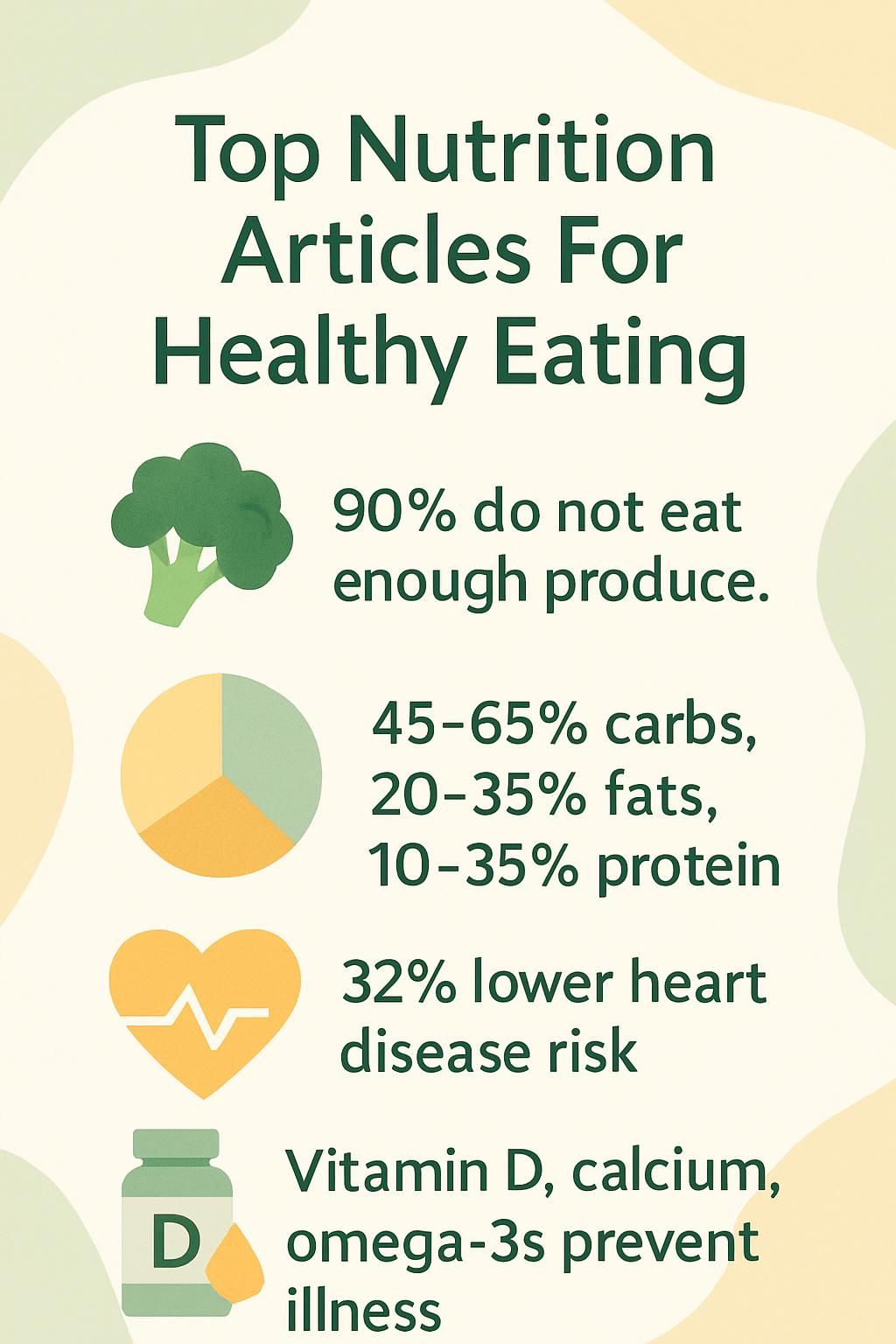Top Nutrition Articles For Healthy Eating
Our Nutrition Assistant AI Suite will transform your body. You will lose fat, get toned, and build muscle. Gain confidence and optimal health.
It is easy to feel lost in nutrition advice. You want healthy eating to be simple and doable. The facts show a clear gap, most Americans do not get enough fruits and vegetables each day. These Nutrition Articles give you practical steps for a balanced diet, smart food choices, and steady habits. You will learn how to use essential vitamins and minerals, set up meals that fit your life, and build confidence at the grocery store.
Key Takeaways
- About 90% of Americans fall short on fruits and vegetables each day, which raises the risk of chronic disease, according to recent dietary guidelines.
- Balanced macronutrient ranges, 45–65% carbohydrates, 20–35% fats, and 10–35% protein, support weight control and long-term health.
- Research from the American Heart Association and NIH links plant-based and Mediterranean patterns to lower heart disease risk by up to 32% and better cholesterol.
- Hydration, portion control, and meal prepping can curb overeating and improve nutrient balance across life stages, based on 2020–2023 findings.
- Key nutrients, including vitamin D, calcium, iron, magnesium, and omega-3s, support bone, brain, and immune health. Deficiencies raise illness risk.

Understanding Nutrition

Nutrition is the way your body uses food for energy, growth, and repair. A healthy dietary pattern lowers the risk of heart disease, diabetes, and unwanted weight gain. Think of nutrition as daily fuel for your cells and your mind.
What is nutrition and how does it affect health?
Nutrition covers how your body absorbs and uses nutrients. Macronutrients are the big three, protein, carbohydrate, and fat. Protein builds and fixes tissues like muscle and skin. Carbohydrates supply quick energy for your day. Fats protect organs, help make hormones, and aid the absorption of vitamins A, D, E, and K.
Vitamins and minerals are micronutrients, the small but mighty helpers. Patterns rich in whole grain foods, calcium, vitamin D, omega-3 fatty acids from fish or plants, and leafy greens support your heart, bones, and immune system.
Good nutrition steadies blood sugar, improves digestion, and supports brain function. It also helps manage body weight by balancing food energy with activity. As a former student athlete, increasing protein after practice reduced soreness and improved stamina over time.
Studies from the National Institutes of Health report that healthy meals support both physical and mental health through effects on blood sugar and mood. Consistent choices create a strong base for lifelong well-being.
Why is good nutrition essential for your body?
Every cell in your body needs steady nutrition to do its job. Without enough protein, iron, or magnesium, fatigue and weakness can follow. Low fiber or vitamin C may lead to digestive issues and a weaker immune response.
Harvard Medical School notes that a balanced diet rich in vitamins and minerals lowers chronic disease risk, including hypertension and heart disease. Healthy fats from nuts and olive oil support circulation. Dairy or fortified alternatives supply calcium for bones. Leafy greens deliver antioxidants that calm inflammation.
Proper food intake keeps organs working well. Poor intake can raise the risk of anemia, unhealthy weight gain from excess saturated fat, or malnutrition among older adults. Choosing more plant-based protein and plenty of fruits adds nutrition without extra empty calories.
A nutritious diet is the foundation for good health throughout life, according to the Dietary Guidelines for Americans.
Essential Nutrients Your Body Needs
Your body depends on a mix of macronutrients and micronutrients. Each one plays a unique role in your energy, growth, and healthy aging.
What are macronutrients: proteins, carbohydrates, and fats?
Macronutrients are nutrients you need in larger amounts for energy and structure. Proteins, carbohydrates, and fats each support health in different ways.
- Protein builds and repairs tissues like skeletal muscle, skin, and organs. Choose lean options such as poultry, beans, or tofu.
- Carbohydrates power your daily activities. Favor whole grains, fruits, and legumes over refined grains and added sugars.
- Fats protect organs, store energy, help make hormones, and allow absorption of vitamins A, D, E, and K. Focus on unsaturated fat from walnuts, seeds, olive oil, and avocado.
- Each gram of protein or carbohydrate provides 4 calories. Each gram of fat provides 9 calories, so watch portions.
- Target calorie ranges, 45–65% from carbohydrates, 20–35% from fats, and 10–35% from protein, based on federal guidance.
- Eating from all food groups helps you cover micronutrients at each meal.
- On long run days, I stayed full longer by adding extra lean protein or a small handful of nuts instead of processed snacks.
Once the macronutrient base is set, vitamins and minerals do the detail work your cells depend on.
Which vitamins and minerals are vital for health?
Micronutrients support thousands of reactions in your body. Here are key players and simple sources.
- Vitamin D aids calcium absorption for bone health. Sunlight helps, and fortified foods or supplements can fill gaps in winter.
- Iron carries oxygen in blood. Low iron can cause tiredness. Include lean red meat, beans, or leafy greens.
- Vitamin B12 supports nerves and red blood cells. Plant-based eaters may need fortified foods or a multivitamin.
- Calcium strengthens bones and teeth and supports muscles. Use dairy or fortified plant milks if you avoid dairy.
- Vitamin A supports skin and immunity. Find it in carrots, sweet potatoes, and leafy greens.
- Folate supports cell division, especially during pregnancy and the teen years.
- Vitamin E acts as an antioxidant that protects cells. Nuts, seeds, and vegetable oils provide it.
- Magnesium supports muscle and nerve function and heart rhythm. Beans, nuts, and whole grains supply this mineral.
- Zinc supports immune defenses and wound healing. Get it from meats, dairy, or whole grains.
- Potassium balances fluids and supports healthy blood pressure. Bananas, potatoes, and beans are simple choices.
After catching colds often, I added vitamin C rich fruits plus zinc sources like pumpkin seeds. Within a few months, I noticed fewer sick days.
Reliable references include the National Institutes of Health Office of Dietary Supplements and the Dietary Guidelines for Americans, 2020–2025.
How does water contribute to proper nutrition?
Water supports every cell and moves nutrients where they need to go. It removes waste, aids digestion, and controls body temperature during heat and exercise.
Even mild dehydration can affect focus at school or work. Choose water instead of sugary drinks to reduce added sugar. You may need more fluids with heavy exercise, certain medications, or higher protein intake. Add fruit slices or berries to water for flavor without extra calories.
Healthy Eating Patterns
A simple plan beats guesswork. Aim for variety, balance, and steady hydration so your routine runs on autopilot.
How to create a balanced diet for optimal health
A balanced diet helps your body work at its best. Use these science-based steps to build meals that are both enjoyable and steady.
- Include all major nutrient groups, proteins, carbohydrates, fats, vitamins, minerals, and water. Each supports energy, repair, and growth.
- Choose a variety of fruits and vegetables for fiber and antioxidants. Berries may support heart health.
- Pick whole grains like oats or brown rice to support digestion and blood sugar control.
- Select lean proteins, fish, beans, poultry, nuts, or eggs. Plant-forward patterns such as the Mediterranean diet can support long-term health.
- Favor unsaturated fats from nuts, seeds, olive oil, and avocados. Limit saturated fat from processed items.
- Include low-fat dairy or fortified alternatives for vitamin D and calcium.
- Stay hydrated. Water helps transport nutrients between cells.
- Watch portions to avoid overeating and support a healthy weight.
- Limit added sugars and sodium. Use food labels to compare options.
- Prep meals ahead with fresh ingredients. Studies from 2020–2023 link meal prepping to better diet quality.
Summary, variety, whole foods, and planning make healthy eating easier day after day.
Why is portion control important for healthy eating?
Portion control keeps calories in check without counting every bite. Large servings can nudge you to eat more, which raises the risk of weight gain and type 2 diabetes.
Restaurant meals often contain two or three times a typical serving, based on Harvard reports. Measuring servings helps you get enough protein, fiber, and minerals while reducing excess sugar and salt.
Practical tips include using smaller plates, serving single portions, and pre-plating snacks. This simple switch helped me cut back on handfuls of nuts at my desk.
What are the best tips for effective meal prepping?
Meal prepping gives you ready-to-eat choices and lowers stress during busy weeks. A little structure goes a long way.
- Set a weekly schedule and plan recipes that cover protein, carbs, healthy fats, and key minerals like potassium and iron.
- Shop for whole foods, leafy greens, berries, nuts, lean meats, and whole grains to boost energy and gut health.
- Use portioned containers to avoid overeating and to pack grab-and-go meals.
- Cook in batches, such as roasting vegetables or chicken, then chill and store safely.
- Label containers with contents and dates to track freshness and reduce waste.
- Keep smart snacks handy, like trail mix, yogurt with probiotics, and fresh fruit.
- Limit caffeine late in the day and skip sugary snacks that can spike and crash energy.
- Rotate recipes weekly for variety in vitamins and minerals.
- Clean your prep area before cooking to reduce contamination risk.
- Freeze extras so you always have nutritious backups on busy nights.
Short recap, plan, portion, label, and rotate. Your fridge becomes a toolkit for healthy choices.
Nutrition for Different Life Stages
Nutrition needs change with age. A few adjustments can support growth, daily energy, and healthy aging.
What nutritional needs do children and teens have?
Childhood and the teen years involve rapid growth. The right mix of nutrients helps bodies and brains develop well.
- Cover the macronutrients, protein for growth, carbohydrates for energy, and fats for hormones and vitamin absorption.
- Prioritize calcium, iron, vitamin D, and zinc. Calcium strengthens bones. Iron supports learning and stamina.
- Offer a range of fruits, vegetables, whole grains, lean meats, or plant proteins. Fiber supports digestion.
- Encourage water throughout the day, especially for active kids.
- Use age-appropriate portions and consistent meals. Growing bodies need regular fuel.
- Create a “rainbow plate.” Different produce colors bring unique nutrients.
- Teen athletes may need more calories and protein for recovery. A registered dietitian can help tailor plans.
- Limit sugary drinks and ultra-processed snacks that affect mood and focus, per CDC research from 2020.
- Manage allergies or vegetarian diets with guidance from MyPlate.gov or a qualified registered dietitian.
I helped a younger cousin through picky phases by letting her pick new veggie colors each week. Trying bright options made mealtimes more fun and less stressful.
How should adults adjust their nutrition?
For adults, the goal shifts to maintenance and disease prevention. Small daily habits add up to strong health markers.
- Eat a wide variety of fruits, vegetables, nuts, and berries. Aim for about 2 cups of fruit and 3 cups of vegetables per day.
- Include lean protein with each meal, such as fish, poultry, tofu, or legumes. Most adults need at least 0.8 grams per kilogram of body weight.
- Choose whole grains instead of refined grains to raise fiber intake for digestive health.
- Focus on healthy fats like olive oil, avocados, nuts, and seeds. These support heart health and vitamin absorption.
- Drink about 8 cups of water daily. Hydration helps your body use other nutrients well.
- Cut added sugars and salt by reading labels. Keep added sugars under 10% of daily calories.
- Consider the DASH or Mediterranean pattern to support blood pressure and heart health.
- Size portions to match your activity level and metabolism.
- Include foods rich in potassium, calcium, magnesium, and iron to cover mineral needs.
- If brain health is a priority, the MIND pattern highlights leafy greens, berries, whole grains, and olive oil.
Weekend meal prep makes workdays easier. Having balanced lunches ready keeps me from grabbing high-sugar snacks when time runs short.
What are the key nutrition considerations for older adults?
With age, energy needs may fall while nutrient needs stay high. A few focus points can protect strength and independence.
- Prioritize protein at each meal to support muscle mass.
- Boost calcium with dairy or leafy greens to protect bones.
- Get vitamin D from fortified foods or safe sun time as skin makes less with age.
- Drink water regularly since thirst cues can be weaker.
- Choose high-fiber foods for regularity and gut health.
- Limit added sugar and salt to help control blood pressure and blood sugar.
- Eat a colorful mix of produce for antioxidants and vitamins.
- Adjust portions if activity slows to prevent weight gain.
- If chewing or taste changes, use softer textures and herbs for flavor instead of salt.
- Ask your clinician about B12 and vitamin D status since absorption often declines.
Helping my grandmother add planned water breaks and more colorful vegetables led to steadier energy on her daily walks.
Spotlight on Popular Nutrition Topics
Different eating patterns can fit different goals. Start with the one that is easiest to maintain.
Plant-based diets explained
Plant-based diets emphasize fruits, vegetables, legumes, nuts, seeds, and whole grains. You limit animal products like meat and dairy. Studies link plant-forward patterns to lower blood pressure and improved cholesterol.
American Heart Association data from 2021 suggests plant-rich eating can cut heart disease risk by up to 32%. Fiber from beans and lentils supports fullness and stable blood sugar.
Starting is simple. Try one meatless day each week with bean soups, lentil tacos, or roasted vegetable wraps. I began with oatmeal plus berries at breakfast and felt more sustained energy.
Overview of the Mediterranean diet
This pattern features fruits, vegetables, whole grains, beans, fish, and healthy fats like olive oil. It limits red meat and sweets. People often flavor meals with herbs and spices instead of salt.
Many studies tie this approach to lower heart and stroke risk. The American Heart Association notes better cholesterol profiles among followers. Eating with others is part of the lifestyle as well.
Fresh, high fiber foods and healthy fats take center stage while processed items stay minimal.
Low-carb and ketogenic diets: what you need to know
Low-carb and ketogenic diets cut daily carbohydrates, sometimes below 50 grams, to shift the body into ketosis. In ketosis, fat becomes the main fuel. Meals center on eggs, meats, leafy greens, nuts, dairy, and oils.
Some people lose weight faster and improve blood sugar control with these plans. The American Diabetes Association notes low-carb diets can help manage type 2 diabetes and lower triglycerides. A 2020 review found greater weight loss in the first six months on keto compared with low-fat plans, then results became similar.
Switching high-carb snacks for cheese or walnuts helped me avoid afternoon crashes. If you try low-carb, include non-starchy vegetables and other nutrient-dense foods to cover fiber, vitamins, and minerals.
How does the DASH diet help manage hypertension?
The DASH diet lowers sodium and increases potassium, magnesium, and calcium. It features fruits, vegetables, whole grains, nuts, low-fat dairy, and lean protein while limiting salty and sugary processed foods.
People following DASH often lower blood pressure within weeks. Reductions of about 11 mm Hg systolic and 5 mm Hg diastolic have been reported. Use herbs and spices for flavor, choose fresh produce over high-sodium canned goods, and check labels for sodium content.
Nutrition and Physical Health
Food choices ripple through your body, from bone strength to long-term disease risk.
Which foods support strong bone health?
Calcium-rich foods like milk, cheese, and yogurt strengthen bones. Leafy greens such as kale and bok choy provide calcium too. Fortified plant milks can match dairy calcium for those who avoid milk.
Fatty fish like salmon and sardines supply vitamin D and omega-3s that aid calcium use. Almonds, chia seeds, sesame seeds, and beans offer magnesium and phosphorus. Eggs add a little vitamin D with protein.
NIH research links balanced, protein-adequate diets to higher bone mineral density. Combining animal and plant protein sources can help maintain bone health across life.
How can nutrition reduce the risk of chronic diseases?
Balanced eating lowers the risk of heart disease, some cancers, and type 2 diabetes. Choose whole grains, fruits, vegetables, legumes, nuts, lean proteins, and healthy fats to protect cells from damage.
Higher fiber intake may cut heart disease risk by up to 30%. Keeping salt lower and limiting processed meats can reduce blood pressure. The CDC reports most Americans fall short on key nutrients like potassium and vitamin D, both important for long-term health.
Small swaps count, water instead of soda, baked chicken instead of fried. Over time, these changes reshape your health profile.
What role does diet play in weight management and metabolism?
Eating patterns shape metabolism and weight control. High fiber foods such as whole grains and vegetables promote fullness and help prevent overeating.
Balanced meals with lean protein, healthy fats, and complex carbs stabilize energy use. Protein requires more energy to digest than simple sugars, which slightly boosts metabolism after meals. Keeping protein steady at each meal can also protect muscle during weight loss.
Replacing sugary drinks with water or unsweetened tea lowered my afternoon cravings within two weeks. Simple steps like this support lasting progress.
Nutrition and Mental Well-Being
Your brain and mood respond to what you eat. Think of meals as quiet support for your mind.
What foods promote emotional well-being?
Fruits, vegetables, whole grains, and fatty fish can support a better mood. People eating five daily servings of produce report higher life satisfaction in some studies.
Omega-3 fatty acids from salmon, tuna, flaxseed, and walnuts may ease depression symptoms, according to Harvard sources from 2022. Leafy greens provide folate, which is linked to lower depression risk. Yogurt and fermented foods add probiotics that support gut health.
Gut bacteria affect the brain through the gut-brain axis. Swapping chips for trail mix with seeds and nuts helped me feel more focused during exams.
Which nutrients help reduce stress and anxiety?
Magnesium supports a calm nervous system. Good sources include leafy greens, nuts, seeds, and whole grains. B vitamins, especially B6 and B12, help your body make serotonin, a mood-supporting chemical. Chicken, eggs, fish, and dairy are useful options.
Omega-3s from fish or walnuts may reduce anxiety by supporting brain function. Complex carbohydrates such as oats and brown rice stabilize blood sugar and concentration. Vitamin C in citrus and bell peppers can lower stress hormone levels.
Probiotics in yogurt may improve gut health and mood. Staying hydrated supports clear thinking under pressure.
How does diet impact brain health?
A nutrient-dense diet supports memory, focus, and long-term brain health. Omega-3s, B vitamins, and folate protect the brain and may slow mental decline.
Studies show that people who eat more fruits, vegetables, whole grains, and leafy greens score better on memory tests. Diets high in added sugar and saturated fat can harm focus and memory.
Antioxidants, iron, and zinc also play key roles. Berries, dark chocolate, and leafy greens are smart picks. Staying well hydrated keeps thinking sharp because even mild dehydration can slow processing speed.
Supplements and Daily Vitamins
Supplements can fill gaps when food alone falls short. Use them to support, not replace, a healthy diet.
When should you consider taking supplements?
Supplements help if your diet lacks certain nutrients or your needs are higher than usual. Vitamin D is a common gap, especially in winter. People who follow vegetarian or vegan diets often need B12, since plants do not supply it.
Pregnant women usually need folic acid and iron. Older adults may need calcium and vitamin D to protect bones. After frequent cramps and fatigue, a blood test showed my magnesium was low. A clinician recommended a magnesium supplement, and symptoms eased within weeks.
Decisions about supplements are best made with a healthcare professional who can review lab results, medications, and life stage needs.
What are common nutrient deficiencies and how to fix them?
Even with a good plan, gaps happen. Simple food swaps often fix the problem fast.
- Iron, low iron causes fatigue. Use lean meats, beans, spinach, or iron-fortified cereal. Add vitamin C foods like oranges to improve absorption.
- Vitamin D, needed for bones and immunity. Get brief sun exposure and include fatty fish, egg yolks, or fortified milk.
- Calcium, crucial for bones and nerves. If you avoid dairy, choose leafy greens, almonds, canned salmon with bones, or fortified juices.
- Vitamin B12, important for energy and brain health. Plant-based eaters can rely on fortified cereal, nutritional yeast, or supplements.
- Iodine, needed for thyroid function. Use iodized salt in cooking. Seafood and dairy also provide iodine.
- Magnesium, supports muscles and nerves. Nuts, seeds, whole grains, and dark chocolate are helpful.
- Folate, vital in pregnancy and for heart health. Leafy greens, beans, and citrus are easy sources.
- Zinc, supports immunity and wound healing. Try beef, poultry, pumpkin seeds, lentils, and chickpeas.
- Omega-3s, aid brain function and reduce inflammation. Choose fatty fish, walnuts, or flaxseeds.
During college, low iron left me tired. Prepped chicken salads and beans during study weeks made a fast difference.
What is the role of probiotics in gut health?
Probiotics are live, friendly bacteria that support a healthy gut. Yogurt, kefir, and fermented vegetables are common sources.
Research shows probiotics can improve digestion and reduce symptoms like bloating or irregularity. Certain strains may lower the risk of antibiotic-related diarrhea.
A healthy gut helps your body absorb nutrients and supports immune function. Many people benefit from a daily serving of probiotic foods.
Nutrition Tips for Athletes
Fueling right helps you train harder, recover faster, and enjoy the process.
How to meet energy needs for athletic performance
Athletes need enough calories and the right mix of nutrients to perform at their best. A simple plan keeps energy stable through training and game day.
- Estimate daily calories based on age, weight, sport intensity, and training time. A teen swimmer may need around 3,000 calories.
- Let complex carbohydrates supply about 50–60% of calories. Oatmeal, brown rice, and whole wheat bread release energy steadily.
- Include lean proteins after hard sessions. Aim for 1.2–2 grams per kilogram of body weight for muscle repair.
- Use healthy fats from nuts, avocados, seeds, and olive oil for long-lasting energy.
- Hydrate before, during, and after activity. Losing just 2% of body weight in sweat can reduce performance.
- Eat every three to four hours to keep blood sugar steady.
- Have a carb-rich snack 1–3 hours before intense exercise, a banana with peanut butter or yogurt with fruit.
- Recover within an hour with both carbs and protein. Chocolate milk or a turkey sandwich works well.
- Track intake and energy levels with a simple log and adjust as needed.
- Consult a registered dietitian for endurance events or special diets.
Strong routine, steady fuel, and smart recovery add up to better training weeks.
Why is macronutrient timing important for athletes?
Timing your protein, carbs, and fats improves energy and repair. Carbs before activity raise available fuel and can delay fatigue. Protein soon after workouts supports muscle repair and strength gains.
Research from the Journal of the International Society of Sports Nutrition shows that eating carbs plus protein within 30 minutes after intense training restores glycogen faster than waiting two hours. Spacing meals evenly across the day can also steady blood sugar during long sessions.
Adjusting my pre-practice snack improved focus during drills. A post-workout smoothie with fruit and protein powder reduced next-day soreness.
What are the best supplements for athletes?
Some supplements can support performance and recovery when used safely. Always check quality and dosing.
- Protein powders help you meet protein targets after workouts.
- Creatine monohydrate boosts power for short, intense efforts and is well studied.
- BCAAs may reduce soreness and support recovery around training.
- Beta-alanine can delay muscle fatigue during high-intensity work.
- Electrolyte drinks replace sodium, potassium, and magnesium lost in sweat.
- Omega-3s from fish oil support joint health and reduce inflammation.
- Vitamin D supports bones and immunity, common to be low with indoor training.
- Caffeine can enhance alertness and endurance before workouts. Keep total intake under 400 mg per day.
- Iron may help athletes prone to deficiency, especially females. Test levels before supplementing.
Work with a sports dietitian to personalize choices and avoid banned substances in competition.
Resources for Further Learning
Good information builds good habits. Use reliable sources that are clear, current, and practical.
Which books and journals are best for nutrition knowledge?
These books and journals offer evidence-based guidance for both beginners and advanced readers.
- Nutrition Essentials for Nursing Practice by Susan G. Dudek, a clear introduction to core concepts and health links.
- Nutrition Facts: The Truth About Food by Karen Frazier, an easy read that corrects common myths.
- Journal of the Academy of Nutrition and Dietetics, peer-reviewed research and clinical trends.
- Modern Nutrition in Health and Disease by A. Catharine Ross, a comprehensive resource on clinical and public health nutrition.
- American Journal of Clinical Nutrition, studies on dietary patterns, metabolism, and disease prevention.
- Precision Nutrition: The Complete Guide to Nutrition Coaching, practical coaching tools for everyday use.
- Eat, Drink, and Be Healthy by Dr. Walter Willett, evidence-based meal planning insights.
- Nutrition Reviews, summaries of global nutrition studies with clear takeaways.
- Harvard Health Publishing, expert tips and readable summaries of new research.
- USDA and NIH websites, government resources for nutrients, meal plans, and supplements.
I used American Journal of Clinical Nutrition articles for a school project and applied the tips to build better meals at home.
What are trusted websites for nutrition research?
Use these credible websites for reliable, science-based nutrition information.
- The Academy of Nutrition and Dietetics (eatright.org) offers expert articles and guidance from registered dietitians.
- The United States Department of Agriculture (USDA.gov) provides MyPlate tools, food databases, and reports.
- The Centers for Disease Control and Prevention (CDC.gov/nutrition) shares national data and prevention tips.
- National Institutes of Health (NIH.gov/nutrition) features research findings, clinical trials, and supplement data.
- The Food and Drug Administration (FDA.gov/food) updates food labeling, claims, safety, and recalls.
- Harvard T.H. Chan School of Public Health (hsph.harvard.edu/nutritionsource) debunks myths and offers meal resources.
- Mayo Clinic (mayoclinic.org/healthy-lifestyle/nutrition-and-healthy-eating) provides clinician-written articles.
- World Health Organization (who.int/health-topics/nutrition) posts global guidelines and public health data.
- Linus Pauling Institute, Oregon State University (lpi.oregonstate.edu/mic) explains vitamins, minerals, and phytochemicals.
Building a trusted reading list helps you sort facts from fads fast.
How can you find a registered dietitian?
Working with a registered dietitian can save time and reduce guesswork. Use these steps to find a qualified professional.
- Use the Academy of Nutrition and Dietetics “Find an Expert” tool to locate credentialed dietitians nearby.
- Ask your primary care clinician for referrals to dietitians they trust.
- Check local hospitals or community health centers for nutrition services.
- Contact your health insurer about coverage and in-network providers.
- Verify credentials with your state licensing board for the RDN title.
- Use telehealth platforms such as Teladoc or Healthie for virtual visits.
- Read reviews on Google Reviews or Healthgrades for personal feedback.
- Attend local seminars or cooking classes to meet dietitians face-to-face.
Conclusion
Healthy eating starts with clear information and small, steady actions. These nutrition articles show how to build a balanced diet, meet vitamin and mineral needs, and form habits that stick. You will find ideas for every life stage plus overviews of popular patterns, from plant-based to Mediterranean.
Use this guide to plan simple meals, prep ahead, and choose water often. Keep portions in check, favor whole foods, and aim for variety. For personal advice, speak with a registered dietitian or your healthcare professional. This content is educational and not a substitute for medical care.
FAQs
1. What topics do top nutrition articles for healthy eating usually cover?
Top nutrition articles often discuss balanced diets, nutrient-rich foods, meal planning strategies, and the health benefits of specific food groups. Many also provide evidence-based tips for making healthier choices at home or when dining out.
2. How can I trust the information in these nutrition articles?
Reputable nutrition articles use data from scientific studies and cite credible sources such as government guidelines or academic research. Look for references to clinical trials or nutritional surveys that support their claims.
3. Are there statistics included in these healthy eating resources?
Yes, many leading nutrition pieces present data on daily nutrient needs, common dietary patterns, and rates of chronic disease linked to diet. For example, a table may show recommended daily values for vitamins like vitamin C or minerals such as calcium.
4. Can personal stories help me understand healthy eating advice better?
Personal anecdotes in trusted nutrition content can make complex ideas easier to relate to real life situations. For instance, reading about someone’s experience with meal prepping might inspire you to try similar habits yourself.
Summary: Top nutrition articles combine clear facts with practical examples; they rely on strong evidence and present key points using simple language supported by reliable data.







